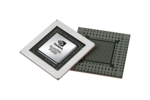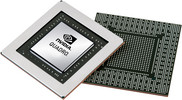NVIDIA Quadro P5000 Max-Q vs NVIDIA Quadro P3000 Max-Q
NVIDIA Quadro P5000 Max-Q
► remove from comparison
The Nvidia Quadro P5000 Max-Q (official Nvidia Quadro P5000 with Max-Q Design) is a mobile high-end workstation graphics card for notebooks. It is the power efficient variant of the normal Quadro P5000 for laptops and offers slightly reduced clock speeds (1101 - 1366 MHz versus 1164 - 1506 MHz) and a greatly reduced power consumption (80 versus 100 Watt TGP). Similar to the consumer GeForce GTX 1070 Max-Q (Laptop), it is based on a slimmed-down GP104 chip with 2048 shaders. The graphics card is designed for the Kaby Lake generation.
The Quadro GPUs offer certified drivers, which are optimized for stability and performance in professional applications (CAD, DCC, medical, prospection, and visualizing applications). The performance in these areas is therefore much better compared to corresponding consumer GPUs.
Performance
The theoretical performance should be slightly below the normal Quadro P4000 due to the reduced clock speeds.
Power Consumption
With an TGP of 80 Watt, the P5000 Max-Q is only slightly higher rated (5 Watt) as the much slower Quadro P3000 (75 Watt) and therefore similar sized laptops can use the P5000 Max-Q.
NVIDIA Quadro P3000 Max-Q
► remove from comparison
The Nvidia Quadro P3000 Max-Q (official Nvidia Quadro P3000 with Max-Q Design) is a mobile high-end workstation graphics card for notebooks. Similar to the consumer GeForce GTX 1060 (Laptop), it is based on the GP106 chip with 1280 shaders. The graphics card is the more efficient version of the normal Quadro P3000 with slightly reduced clock speeds at a much reduced power consumption (60 Watt versus 75 Watt TGP).
The Quadro GPUs offer certified drivers, which are optimized for stability and performance in professional applications (CAD, DCC, medical, prospection, and visualizing applications). The performance in these areas is therefore much better compared to corresponding consumer GPUs.
Performance
The theoretical performance should be only slightly below the normal Quadro P3000 (as it was with the Max-Q GTX 1060 versus the normal GTX 1060).
| NVIDIA Quadro P5000 Max-Q | NVIDIA Quadro P3000 Max-Q | |||||||||||||||||||||||||||||||||||||||||||||||||||||||||||||||||||||||||||||||
| Quadro P Series |
|
| ||||||||||||||||||||||||||||||||||||||||||||||||||||||||||||||||||||||||||||||
| Codename | N17E-Q5 Max-Q | N17E-Q1 Max-Q | ||||||||||||||||||||||||||||||||||||||||||||||||||||||||||||||||||||||||||||||
| Architecture | Pascal | Pascal | ||||||||||||||||||||||||||||||||||||||||||||||||||||||||||||||||||||||||||||||
| Pipelines | 2048 - unified | 1280 - unified | ||||||||||||||||||||||||||||||||||||||||||||||||||||||||||||||||||||||||||||||
| Core Speed | 1101 - 1366 (Boost) MHz | 1075 - 1240 (Boost) MHz | ||||||||||||||||||||||||||||||||||||||||||||||||||||||||||||||||||||||||||||||
| Memory Speed | 6006 MHz | 7008 MHz | ||||||||||||||||||||||||||||||||||||||||||||||||||||||||||||||||||||||||||||||
| Memory Bus Width | 256 Bit | 192 Bit | ||||||||||||||||||||||||||||||||||||||||||||||||||||||||||||||||||||||||||||||
| Memory Type | GDDR5 | GDDR5 | ||||||||||||||||||||||||||||||||||||||||||||||||||||||||||||||||||||||||||||||
| Max. Amount of Memory | 16 GB | 16 GB | ||||||||||||||||||||||||||||||||||||||||||||||||||||||||||||||||||||||||||||||
| Shared Memory | no | no | ||||||||||||||||||||||||||||||||||||||||||||||||||||||||||||||||||||||||||||||
| API | DirectX 12_1, Shader 5.0, OpenGL 4.5 | DirectX 12_1, Shader 5.0, OpenGL 4.5 | ||||||||||||||||||||||||||||||||||||||||||||||||||||||||||||||||||||||||||||||
| Power Consumption | 100 Watt | 60 Watt | ||||||||||||||||||||||||||||||||||||||||||||||||||||||||||||||||||||||||||||||
| technology | 16 nm | 16 nm | ||||||||||||||||||||||||||||||||||||||||||||||||||||||||||||||||||||||||||||||
| Features | Optimus, PhysX, 3D Vision Pro, nView, Optimus | Optimus, PhysX, 3D Vision Pro, nView, Optimus | ||||||||||||||||||||||||||||||||||||||||||||||||||||||||||||||||||||||||||||||
| Notebook Size | large | large | ||||||||||||||||||||||||||||||||||||||||||||||||||||||||||||||||||||||||||||||
| Date of Announcement | 11.01.2017 | 01.09.2017 | ||||||||||||||||||||||||||||||||||||||||||||||||||||||||||||||||||||||||||||||
| Link to Manufacturer Page | www.nvidia.com |
Benchmarks
* Smaller numbers mean a higher performance
1 This benchmark is not used for the average calculation
For more games that might be playable and a list of all games and graphics cards visit our Gaming List


 Deutsch
Deutsch English
English Español
Español Français
Français Italiano
Italiano Nederlands
Nederlands Polski
Polski Português
Português Русский
Русский Türkçe
Türkçe Svenska
Svenska Chinese
Chinese Magyar
Magyar